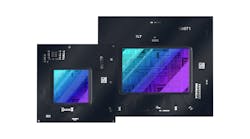Intel Takes on AMD, NVIDIA with First Discrete GPU for PCs
When Intel recruited chip architect Raja Koduri from AMD’s graphics processor business in 2017, it signaled the company was serious in its ambitions to take on AMD and NVIDIA in high-end discrete graphics. Now, after half a decade of R&D, it has finally introduced its first standalone graphics chips.
Intel last month launched a new family of discrete graphics processing units (GPUs), called the Arc A-series, designed to run video games and other graphics-heavy workloads on laptops and desktops. It is rolling out the first members in its family of consumer graphics chips, Arc 3, that offer more graphical firepower to compact, ultralight laptops than the integrated graphics in its central processors for PCs.
The company said the Xe High-Performance Graphics microarchitecture, or Xe-HPG, underpinning the Arc 3 family of GPUs, code-named Alchemist, is designed from the ground up for gaming and creative tasks. The Xe-HPG is a close relative of the Xe-LP architecture used in its Iris Xe series of integrated GPUs, trading the high-performance of a standalone GPU at the expense of consuming more power.
The fundamental building block of Intel’s Arc GPUs is the “Xe” core. Every Xe core integrates 16 “XVE” vector engines that are designed to run computations while running games, including rasterization. Every Xe core also incorporates 16 “XMX” engines specifically to carry out AI operations, playing a similar role as the tensor cores in NVIDIA’s rival RTX GPUs. Every core adds 192 kB of shared L1 cache, which can be used to save instructions during computing workloads, or shaders and textures while rendering games.
Inside Arc 3, the company has united every Xe core with a real-time “ray-tracing” processing unit that is designed to help video games and other computer graphics more accurately recreate shadows and reflections in a scene.
The Xe cores are also supplemented by specific technologies for media encoding used by streaming videos. The Xe Media Engine inside Arc 3 supports acceleration for a broad range of standard video codecs and includes industry-first AV1 hardware-accelerated encoding and decoding. AV1 is up to 50% more efficient than the industry-standard H.264 video codec and 30% more efficient than H.265.3. The Xe Display Engine handles high-resolution, high-refresh-rate HDR displays and standards including Display Port 2.0.
Intel said all these building blocks are arranged into so-called “render slices” that each contain four Xe cores and four ray-tracing cores, along with all the other components of a modern graphics processor.
The render slices are connected via a high-bandwidth memory fabric with a large L2 cache. This gives Intel the flexibility to scale up the Xe HPG microarchitecture for high-performance gaming GPUs with up to eight slices.
Intel touted the Arc 3 family as a major step up from the integrated GPUs in its flagship CPUs for the personal-computer market. The family includes the A350M, with six Xe cores and six ray-tracing cores consuming 25 to 35 W, and the A370M, with eight Xe cores and eight ray-tracing units that expend up to 50 W. Intel said the Arc 3 graphics chips support enhanced 1080p gaming at more than 60 frames/s.
Both GPUs can be connected to 4 GB of GDDR6 memory, and they support PCIe Gen 4 for connectivity.
The Arc series of GPUs is also a sign of Intel’s willingness under CEO Pat Gelsinger to rely on contract chip foundries. Once famed for its manufacturing prowess, Intel is using TSMC to manufacture the Arc 3.
According to the company, many of the first laptops to feature Arc A-Series GPUs will also include CPUs from its latest generation of client CPUs. These PCs can use a technology called Deep Link to do dynamic power-sharing and bolster performance. The technology intelligently adjusts the amount of power routed to the GPU and CPU based on which processor plays a bigger role in running a program.
“Intel Deep Link enables dynamic power-sharing, intelligently distributing power across the platform to increase performance up to 30% in creation and compute-intensive applications,” said Roger Chandler, Intel's VP of graphics and gaming.
Intel said the Deep Link technology taps into both the integrated Xe GPU in its flagship CPUs and standalone Arc GPUs to offer faster media encoding and image processing. The Hyper Encode feature combines media engines from the CPU and GPU to run video-encoding workloads up to 60% faster than its Iris Xe Graphics alone. Hyper Compute uses the combined resources of the CPU and GPU to speed up AI workloads.
The company has partnered with top OEMs such as Dell, Lenovo, HP, Samsung, and many others to roll out laptops for gamers and professionals that feature Arc 3 GPUs, with prices starting at around $900.
Furthermore, Intel is targeting high-performance mobile GPUs for gaming. It has plans to release the Arc 5 and Arc 7 GPUs later in the year, which will have more graphics cores, ray-tracing units, and memory at the expense of a higher power envelope compared to Arc 3. Intel is also eyeing NVIDIA’s dominance in the market for desktop GPUs, announcing that its first product in the category will be available by mid-2022.
The company has previously said that its accelerated computing and graphics business, led by Raja Koduri, would grow to around $1 billion in sales by 2022.
About the Author
James Morra
Senior Editor
James Morra is the senior editor for Electronic Design, covering the semiconductor industry and new technology trends, with a focus on power electronics and power management. He also reports on the business behind electrical engineering, including the electronics supply chain. He joined Electronic Design in 2015 and is based in Chicago, Illinois.





